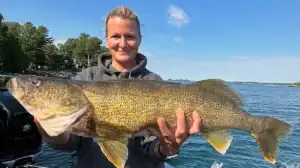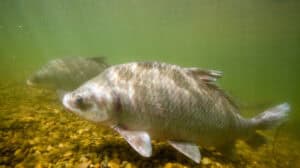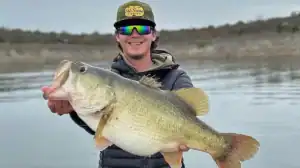Long-time fishing pro Bernie Schultz has been working with Fuji and their rod components and has come to realize the importance of the components on rods and how they can help or hurt a rods sensitivity and performance.
The following Q&A talks discusses Fuji’s new KR Concept, a recent advancement in rod component technology.
Q: Before spending time with Fuji, did you have any preconceived ideas about the role of components in overall rod performance?
A: I’ve always fished factory rods, and although many have had Fuji components, I discovered I was way behind the curve on some of the technological advances made in recent years. Some of the newest information is almost counter-intuitive. For example, who would think a smaller ring size would actually allow fishing line to move more efficiently through the guides? You’d think a larger opening would allow faster flow and longer casts, but that’s just not the case. Learning that was a real eye-opener!
Q: I assume you’re referring to the recent popularity of “micro-guides”?
A: Yes!…particularly when it comes to braid or fluorocarbon. I’m convinced the micro guide layouts are the best way to fully realize the performance boosts that these lines bring to the table. The KR Concept that we tested has been carefully researched by Fuji, the worlds leading component maker, and their findings point directly to rod design as it relates to these new high-performance fishing lines. Mono works well with this new concept, too.
Q: Does all the new information translate into measurable improvement on the water?
A: Absolutely! I’m a better angler…and by that I mean I’m thinking more about the fish and less about the equipment I’m casting with. I believe this new technology will help the average angler too.
Q: How’s that?
A: Well, take the fatigue factor, for example. A guy who fishes mostly on the weekends can’t possibly develop the muscle memory to make as many casts in a day as, say, a tournament angler. But, if you offer him a lightweight graphite rod properly fitted with the right components, he’ll make a lot more casts and possibly fish longer because he won’t get tired. In almost every case that will mean more success in a day’s fishing.
Q: I assume you can list more benefits of micro guides?
A: Well, the KR Concept uses smaller guides, but I tend to think of the whole thing as a “point of view” rather than a micro-guide layout scheme.
Q: What do you mean?
A: In talking to custom rod builders, I’ve sort of changed my way of thinking. They don’t say, “Use a 3mm guide.” They always relate to the end game with statements like, “Use the smallest guide that will accomplish the angling task at hand.” Sometimes that’s a 3mm ring, sometimes it’s a 6mm ring. It’s not a micro guide layout as much as it’s a method for reducing weight and preserving rod performance as much as possible.
The KR Concept may appear to be about new micro products, but it’s more about controlling line flow and reducing weight to get every last bit of performance from the rod blank.
Q: You mentioned “line flow” a couple of times. I assume it’s important, but can you elaborate as to why?
A: The moment you make a cast, line leaves the spool at incredible speed. What may look fairly smooth and normal to the eye is actually a chaotic mess when viewed in slow motion. Line is bouncing around inside the guides, slapping the rod blank, overrunning the guide frames, loops form…it’s amazing a cast is ever made successfully. Components that are properly designed to control and smooth line flow offer a huge boosts in overall performance of a rod.
Q: Is this something you can measure?
A: It’s difficult because things happen so fast. The best evidence, or proof, is the added casting distance you get from a well designed component train. By that I mean how the guides are laid out.
Q: Can you tell us why the new KR rods cast further?
A: Assume you’re making a cast. As you load the rod in the backcast, energy is stored, then suddenly released as you move the rod toward the target. That energy combined with the weight of your lure is what allows you to reach the target. Every time the line slaps the blank or is unnaturally restricted by the guides, that energy is compromised, as is your casting distance. A better designed guide train would, instead, maximize this. And the cast would be accomplished with considerably less effort.
Effortless casting seems to equate to accuracy as well. That’s one of many important aspects of smooth line flow.
Q: Is this something you can see?
A: You can see it, especially if you use a bright colored line. More importantly, you can feel and hear the difference. Compared to conventionally built rods, smooth flowing line creates almost no vibration in your hand and can barely be heard as it slips through the guides. It’s even more obvious in spinning rods.
Q: So how does the KR Concept accomplish all of this?
A: The guides developed for this application were carefully designed to hit the “sweet spot” between the frame height of the guide and the ring size. In spinning for example, the guides have very high frames and very small rings. The goal is for the first guide to accept the line coming from the spool, then “choke” the coils as quickly as possible into a smooth flow. The real magic is in figuring out how much, how fast, and where on the blank to achieve it. In every case, however, micro guides do the job better than anything else. So Fuji’s answer to the whole micro guide craze is the KR Concept.
Q: Earlier, you mentioned “weight” as it relates to micro guides. Combined with the small size of a guide, how important is weight?
A: When you combine smoother line flow offered by micro guides with their lower overall weight, it’s like turbo-charging the rod. Exponential improvements occur inherently when weight is reduced. Rods become far more responsive and sensitive. They even become more powerful!
Guides create contact points with the line and KR Concept layouts use more guides—more guides mean more sensitivity without added weight. Less overall weight makes subtle strikes much easier to detect. There are so many additional benefits with a well designed micro guide set up.
Q: Smoother, lighter, more sensitive, they cast further…are we missing anything?
A: Recovery. That’s something most anglers never consider, yet it’s actually quite important. The KR Concepts’ super light tip section drastically reduces oscillation at the end of the rod blank. These rods snap back to their original position almost instantly, because the tips are so light there’s not enough weight to make them wobble or vibrate during a cast.
I think the faster recovery combined with smoother line flow in a KR Concept rod allows me to be more accurate, and I believe it will do the same for any fisherman. Like I said, I don’t have to think about the rod…it doesn’t matter if I’m pitching, skipping, or using a backhand cast—just think it and it’s there!
Q: What about actually catching a fish?
A: Again, having more guides will track the line closer along the blank, so when you set the hook you’re moving the fish more than a rod where the line is “turning corners” from one guide to the next. It translates to more power during a fight, better lure control and a one heck of a hook-set.
Q: Now that the KR concepts have been introduced, can we assume that conventional guide set-ups are a thing of the past?
A: It’s a move that will help maximize the capabilities of newer higher-modulus graphite rods. The real question is; why would you take a high dollar 7-foot blank that weighs a mere 1.5 ounces and add heavy components to it? That would only negate what you just paid top dollar for.
In specific applications, micros may well become the guide layout of choice. But there will always be applications that use softer blanks, like crankbait rods and certain saltwater rods, where larger heavier guide trains will have little or no effect on performance. It will be a long time before they stop making bigger guides.
Q: Will you be using KR Concept rods on the Sabine River during the opener of the 2013 B.A.S.S. Elite Series Tournament Trail?
A: I’ve already snuck some of the research rods into the back of my truck.










